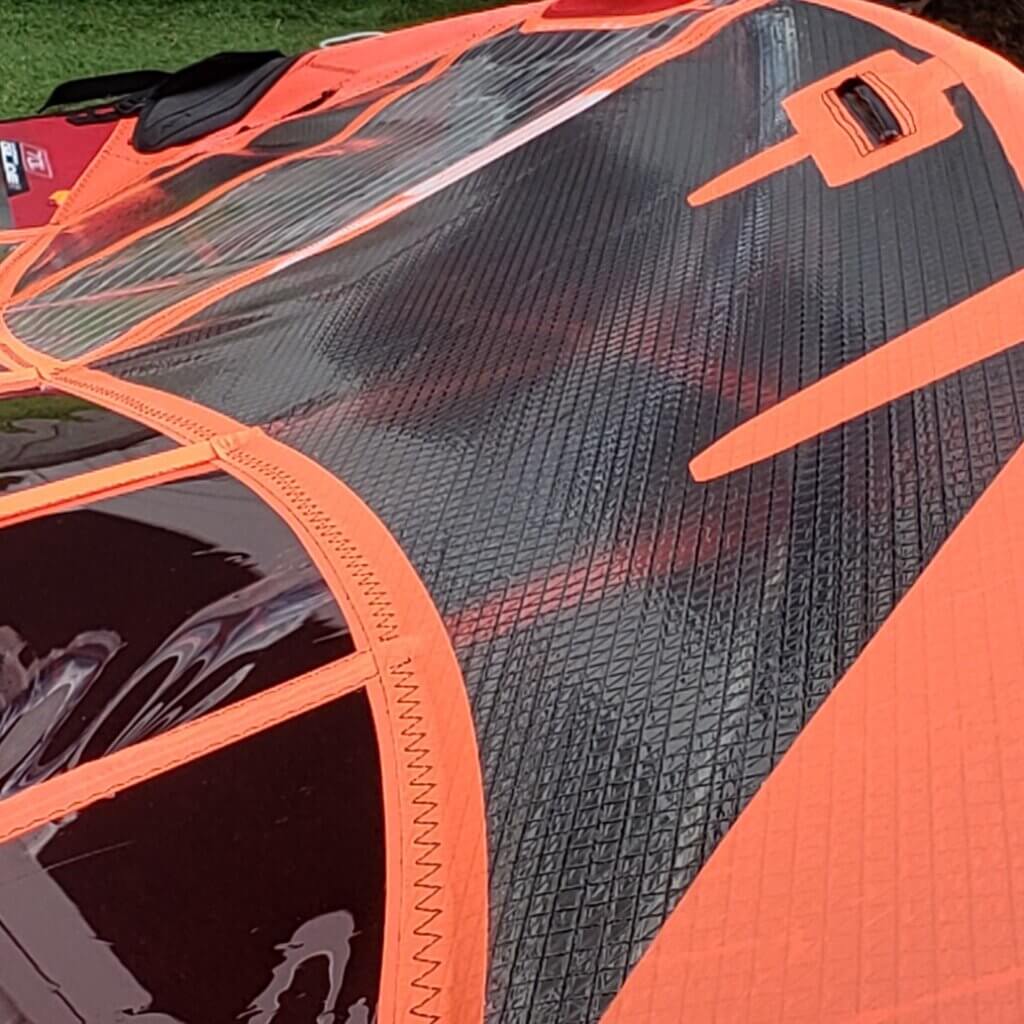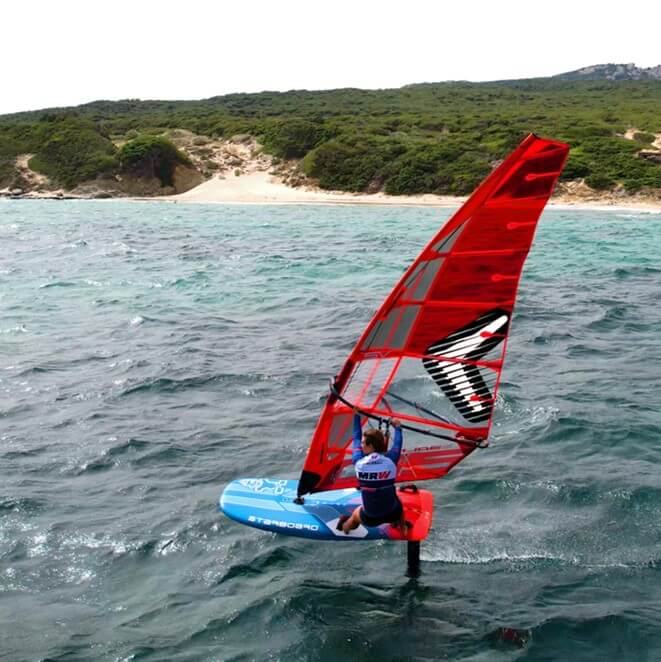The Severne Olympic HGO sailing has already seen everyone fly by once. But the Severne Hyperglide sails are (even) less often seen on the water. In this review of the Severne Hyperglide 5 we pay attention to what the differences are between the Olympic sail and why you should buy the Severne Hyperglide 5.
Hyperglide 5 softer and more stable than Hyperglide 4
Visually, it is striking that the mast cover has not only become almost completely transparent, but is also a lot wider. This makes the sail more stable and the extra power in the sail is easier to control. The Severne Hyperglide 5 is available in sizes, 5, 6, 7, 8.9 and 10 m2. All sizes have 7 leaves of which 4 with cambers.
The small sizes up to 8.0m2 are optimized for slalom foiling and the 9 and 10 m2 are developed for up and down wind racing. According to Severne, the sails come into their own best with SDM masts (also for the smaller sizes), as an alternative the 5.0m2 and 6.0m2 can be rigged on an RDM mast. For all sizes, the boom lengths have decreased slightly and the mast lengths have become fractionally longer.

We are the first to test the 7.0m2. What is immediately noticeable with rigging is that the precipitating voltage is slightly less than the previous model, the Hyperglide 4, and that the cambers also rotate a little easier. Because of the enormously wide mast cover, it seems as if the sail is less convex, but appearances are deceiving. The depth of the bulge is similar to the Hyperglide 4. For the review we use the Starboard Foil Slalom 81 with the Starboard slalom foil (105 cm EVO fuselage) with the new Starboard SLR wings.
Severne Hyperglide 5 softer and with more low end power than Severne Mach sailing
We have been asked by many of our customers whether the Severne Hyperglide 5 sails are not too much ‘high end’ with only power in the higher wind range such as the traditional fin slalom racing sails such as the Severne Mach sails. The Hyperglide 5 sails feel clearly softer than the Mach sails and also deliver a lot of power in the lower wind range. Although the sails have a bit more loose leach than the HGO sails or Foilglide 2 , you can ‘pump’ the sails very well and you can wind foil amazingly early with these sails. The pressure point sits nicely in the middle of the sail and stays in the same place even with strong winds. That makes these sails extremely stable, where you also have the pressure on the right place with little wind. This really ensures that you can stay stable with wind foiling much easier in gusty winds.
For those who are familiar with the Foilglide sails from Severne, the Hyperglide 5 gives almost as much power in the low wind range as the Foilglide 2! Only because of the SDM mast and higher downing voltage there is less flex in the mast, so pumping requires a slightly different technique! In terms of weight, only the 5.0 m2 and 7.0 m2 are heavier than the Foilglide 2, but the 6.0 m2 and 8.0 m2 are even lighter in weight than the Foilglide 2. Despite the fact that the sail has more slats and more cambers!!
The very stable pressure point ensures that the sails feel very predictable at all times during wind foiling with the added low weight, makes these sails feel extremely light during wind foiling, which also benefits the handling. The sail rotates very finely. The cambers easily turn over with the hijacking, so you do not slow down much when you come out of the foiling hostage. Then the sail gradually builds up pressure again to accelerate nicely again.
Hyperglide 5 very versatile, with maximum performance in the higher wind range
We have compared the 7.0 m2 in the lower wind range (9 to 12 knots) with the Severne FGO 7.0 m2 and in terms of low end power the sails go the same way. From about 15 to 16 knots, the Hyperglide 5 is really the better and faster sail. Where does it end? That really depends on your own abilities, guts and weight. We thought the 7.0 m2 around 20 knots became too big. The sail provided so much power that we could no longer pull the sail closed to the maximum (half wind course). Where we noticed that the pressure point still remained neatly in place.
We also tested the Hyperglide 5 with the IQfoil racing foil with Iqfoil 85 . Also in this set up the Hyperglide is a very nice sail, where you of course come up a little earlier by the IQfoil racing foil. Upwind feels the sail a little more nervous due to its short boom length (7.0m2 has a boom length of 196 cm), there the FGO 7.0 m2 feels slightly better (up to about 16 knots). But well the Hyperglide 5 7.0m2 is intended for half wind and downwind races.
The Hyperglide 5 6.0 m2 feels relatively small compared to the 7.0 m2 in one way or another. This sail also provides a lot of power in the lower wind range. Also in a direct comparison with the Severne FGO 6.0 m2 we saw that the power in the lower wind range is similar. But that light feeling on the foil is expressed in an enormous speed and super control. With a similar wind foil set up, the sail with about 16-18 knots half wind was really noticeably faster than the 7.0 m2 (with our weight), despite the fact that we did not yet feel that we had full power with the 6.0 m2. We clearly noticed that the 6.0 m2 delivers less down force, so we had more lift in the foil compared to the 7.0 m2. This also ensures that with the 6.0 m2 you can wind foil faster with smaller wings.
Wind foil set up of vital importance
In recent months we have spent many 10-horse hours on our slalom foil sets where we have tuned a lot. See also our review about the Starboard slalomfoil 81, Starboard GTR Slalomfoil and the new Starboard SLR wings. What has become clear to us is that the set up of the wind foil is the most important thing and has a direct impact on the feel of the sail and the power you feel. A back wings spacer with angle that is just a 1/2 degree too little, can already cause you to feel little power in your sail and you are not comfortable on your board. Our experience is that the tuning of the wind foil has about 50% impact on the tuning of the sail 35% and of the board 15%.
Who is the Hyperglide 5 for?
To put it bluntly, the Hyperglide 5 is a very accessible and stable performance sail. We were pleasantly surprised how wide the range of use is, both with low wind and with a lot of wind. But the potential of the sail really comes into its own with slalom foiling in the higher wind range. Compared to the previous version (Hyperglide 4), the sail feels softer, and better balanced. This ensures that you can wind foil relaxed and with a lot of control. As a result, the new generation of Hyperglides are noticeably a lot faster than with the previous version. Who appeals to these qualities?;
- Of course the slalom/speed wind foilers that go for 50 km/h plus. Easy to 😉 with these sails
- But also free racers who are looking for a slightly more stable and faster sail than the Foilglide 2 appreciate this sail. The handling is very light
- If you don’t have an extreme slalom foil set up, the Hyperglide 5 works fine.
- Don’t choose too big with the Hyperglide 5. The sails deliver more power than you expect from such a ‘race oriented’ sail. And bigger doesn’t automatically mean faster
Background information
1. Severne Hyperglide 5 vs Severne HGO Olympic Sail
To be able to make the difference between the Severne HGO and HG5 sails clear, we have to go back a few years. At the end of 2019, the Olympic committee chose the Starboard / Severne IQfoil concept as the new format for the upcoming Olympic Games. The design of the chosen material of this new unit class will therefore not change until the 2024 Olympic Games (and perhaps longer). The HGO is available in an 8.0m2 and a 9.0m2 with a strong focus on up/down wind courses with an extremely wide range of applications.
We are now 3 years further and the developments in wind foiling do not stand still. The most important development we now see in the PWA where slalom foiling has become the norm. The Severne Hyperglide 5 is based on the HGO, but has been further developed in recent years, whereby the sizes from 5.0 m2 to 8.0 m2 have been developed for slalom foiling and the sizes 9.0 m2 and 10 m2 for wind foiling. Steps have clearly been taken in reducing the resistance of the sails and making them even more stable.
2. Severne Hyperglide 5 vs Severne Mach 5
The Hyperglide and Mach sails are 2 completely different sails, developed for demanding foilers and slalom surfers. The Hyperglide 5 has a relatively longer mast and a lot shorter boom than the Mach 5 sails. The Hyperglide sails are therefore called high aspect sailing. The aspect of the Hyperglide 5 = 2.5 (mast length / boom length) and for the Mach 5 this is 2.3.
This does not seem like such a big difference, but the mast of Hyperglide 5 7.0 m2 is 29 cm longer than that of the Mach 5 7.0 m2. And the boom length of the Hyperglide 5 7.0 m2 is 16 cm shorter than the Severne Mach 5 7.0 m2 at 196 cm. And the differences are not limited to just the dimensions.

Difference in pressure point foil sails and fin sails
The more compact shape of the Hyperglide 5 ensures that the sail is more stable and that pressure point is more or less in the middle. With the Mach sails, the pressure point is a little further back. You can assume that the pressure point of the Hyperglide is more or less at the location of the front wing and the pressure point of the Mach sails at the level of the fin. That also means that with a Hyperglide you can wind foil much more easily stable, because the pressure point is in a different place. (read: exactly above the front wing makes it easier to keep the wind foils stable).
Difference in downforce foil sails and fin sails
Another big difference is that foil sails generate less downforce than fin sails. With wind foiling you want to get to the foil quickly and have as much lift as possible with the smallest possible wings. With fin surfing you want your board to be pressed on the water to be able to keep control of the set at high speed.
Low end properties foil sails and fin sails
One of the big advantages of wind foiling is that you can already wind foil with very little wind. That does not always happen automatically, you need a sail that also ‘works’ with little wind. The sail must not only provide sufficient power, but you must also be able to pump effectively with it. That is why the foil sails feel softer, with often less tension and less loose leach than the fin sails. That means that the Severne Hyperglide 5 sails also do well in the lower wind range. Because the PWA boys and girls also want to get on the foil with as little wind as possible and have a lot of power!
Want to try Severne Hyperglide 5 for yourself?
By appointment it is possible to test the Severne Hyperglide 7.0 m2 or 6.0 m2. This is only possible if you can already wind foil yourself. If you want advice or want to test the sails, please send us an email.


